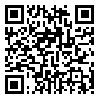Volume 16, Issue 53 (August 2006)
J Mazandaran Univ Med Sci 2006, 16(53): 57-67 |
Back to browse issues page
Abstract: (15981 Views)
Background and purpose: The increased prevalence of pediatric obesity in Iran, and its associated morbidity, with its proven correlation with abdominal adiposity, is assessed by waist circumference(WC). The purpose of this study was to identify predictors of obesity among macronutrient intakes in a group of Tehranian children.
Materials and Methods: 343 children aged 5-13 years (194 boys, 149 girls) were randomly recruited among participants of the Tehran Lipid and Glucose Study. Body size was measured based on the McCarthy et al. survey. Children with WC of over 90th percentiles were considered overweight. Dietary intake data were assessed by trained interviewers using two non-consecutive 24-hour recalls. Under-reporters of energy intake were excluded from the study. Dietary composition was assessed in terms of calorie-adjusted amount of macronutrients intake and absolute dietary intakes. They were entered in multiple regression models controlling for confounding variables and mutual effects of other macronutrients.
Results: The average WCs of children 5-8 y and 9-13 y were 52.9 ± 5.6 and 62.9 ± 10.1 cm, respectively. Prevalence of overweight in girls did not differ significantly from boys. Absolute and adjusted dietary protein intakes were positively associated with WC in 5-8 y old boys and girls, respectively (ß=0.63, p<0.001 and ß= 0.55, p<0.001). In girls, only the absolute amount of fat intake contributed to WC (ß=0.32 p<0.001 and ß=0.3, p<0.01). Energy-adjusted and absolute amounts of carbohydrate intake were found to be negatively associated with WC in boys (ß= -0.23 up to -0.3, p<0.001).
Conclusion: The results demonstrated a positive association between protein intake and WC in 5-8 y children, whereas only absolute amounts of fat intake were positively associated with obesity in girls. Pediatric abdominal obesity was found to be inversely correlated with carbohydrate intake.
Materials and Methods: 343 children aged 5-13 years (194 boys, 149 girls) were randomly recruited among participants of the Tehran Lipid and Glucose Study. Body size was measured based on the McCarthy et al. survey. Children with WC of over 90th percentiles were considered overweight. Dietary intake data were assessed by trained interviewers using two non-consecutive 24-hour recalls. Under-reporters of energy intake were excluded from the study. Dietary composition was assessed in terms of calorie-adjusted amount of macronutrients intake and absolute dietary intakes. They were entered in multiple regression models controlling for confounding variables and mutual effects of other macronutrients.
Results: The average WCs of children 5-8 y and 9-13 y were 52.9 ± 5.6 and 62.9 ± 10.1 cm, respectively. Prevalence of overweight in girls did not differ significantly from boys. Absolute and adjusted dietary protein intakes were positively associated with WC in 5-8 y old boys and girls, respectively (ß=0.63, p<0.001 and ß= 0.55, p<0.001). In girls, only the absolute amount of fat intake contributed to WC (ß=0.32 p<0.001 and ß=0.3, p<0.01). Energy-adjusted and absolute amounts of carbohydrate intake were found to be negatively associated with WC in boys (ß= -0.23 up to -0.3, p<0.001).
Conclusion: The results demonstrated a positive association between protein intake and WC in 5-8 y children, whereas only absolute amounts of fat intake were positively associated with obesity in girls. Pediatric abdominal obesity was found to be inversely correlated with carbohydrate intake.
Type of Study: Research(Original) |
| Rights and permissions | |
 |
This work is licensed under a Creative Commons Attribution-NonCommercial 4.0 International License. |


